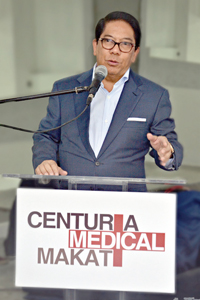Sub-industry helps pay bills for Israeli healthcare but still requires oversight, Knesset committee is told.

MK Haim Katz (Likud) Photo: Marc Israel Sellem
Medical tourism will be regulated through legislation, Likud MK Haim Katz, chairman of the Knesset Labor, Social Welfare and Health Committee, said on Monday during discussion of a Channel 2 investigation into the treatment of foreigners by three surgeons at Tel Aviv’s Sourasky Medical Center.
Health Minister Yael German added that medical tourism was beneficial because “it gives doctors experience” and can be shifted from the center of the country, where is it largely practiced, to the periphery.
Katz claimed that “unfortunately, both the Finance Ministry and the hospitals don’t listen to the Health Ministry’s instructions on the matter; thus regulation has to be legislated.
I have the impression that treating foreign patients well spreads the good name of Israel and serves as an ambassador of good will.”
However, health experts maintain that the ministry has not issued clear guidelines on what is and isn’t permitted for physicians who treat foreign patients, leading to findings by the investigative program Uvda on doctors who allegedly take payments for neurosurgery and cardiac surgery performed on foreigners at the medical center.
Over the years, while ministry professionals have long been in favor of regulation, politicians from the Prime Minister’s Office on down have pushed for encouraging almost unlimited medical tourism, they say.
German cited a “shortage of money” in the health system.
“In the coming years, we won’t get [from the Treasury] the NIS 8 billion we need for public health, so we need to consider additional sources of funds while carefully preserving equity and justice,” she said.
“The topic worked under the radar screen because there was no regulation,” she continued.
“It is clear that medical tourism cannot be abolished. Think of the possibility of an online system in which we could know where there are empty beds at any given moment in the hospitals, where we would refer foreign patients…. With proper regulation, we will be able to serve the Israeli pubic and enrich the public purse.”
Health Ministry director-general Ronni Gamzu – who previously was director-general of the Sourasky Medical Center’s Ichilov Hospital – said he bore some responsibility for the growth in medical tourism, although he admitted that this growth had become “problematic.”
“The pay for a surgeon who treats a tourist is three or four times what he gets for operating on an Israeli patient,” Gamzu said. “Already today, I will rush instructions to hospitals that they must not pay those who operate on foreign tourists any more than they get for operating on local residents.”
To this, Israel Medical Association director-general Leon Eidelman said: “You have killed it [medical tourism in the public hospitals]. They will all go for surgery to Assuta [Medical Centers, the chain of private hospitals].”
Sheba Medical Center director- general Zev Rotstein said that medical tourism “raises the level of Israel medicine,” thus benefiting all Israelis.
“The treatment is provided after the doctors’ regular working hours and not at the expense of Israelis,” Rotstein explained. “The share of foreigners compared to Israelis in my hospital is only 15 percent, and the income is only 6.36% of Sheba’s total income. But this money is important because I can’t get it from the government. Regulation is not the solution for everything.
Sometimes it interferes. Let the hospital managers run things.”
Labor MK Mickey Rosenthal said that funds from medical tourism must go the periphery, “where residents live a decade less on average than those in the center of the country.”
Meretz MK Ilan Gillon argued that he wanted the health ministry to finance “my healthcare, and not that of a tourist from Uzbekistan.”
Meanwhile, Katz – in a separate committee discussion on health fund deficits – said a proposed NIS 75 million for insurers was much too small.
“This is a pitiful sum that covers almost nothing, and it is due to be given only from next year,” he said. “The Treasury is smashing the health system. It can’t be that all the experts… say there is a huge deficit, and only the boys at the Treasury, who only yesterday graduated from university, say something else.”
Bank of Israel economist Eran Pulitzer said the gap in health funding was “liable to cause harm in the level of services.”
Zev Wurmbrand, director of Clalit Health Services, said that some NIS 700m. was needed by the health funds to cover deficits just from 2013.
“At the same time, there must be supervision to ensure that the money will go to improve services, and not to salaries,” he said.
source: http://www.jpost.com / Jerusalem Post / Home> Health & Science / by Judy Siegel-Itzkovich / December 23rd, 2013

![The women are using forged doctors notes to board the aircraft [GETTY]](http://www.caretourism.org/wp-content/uploads/2014/01/pregnantCT27jan2014.jpg)





